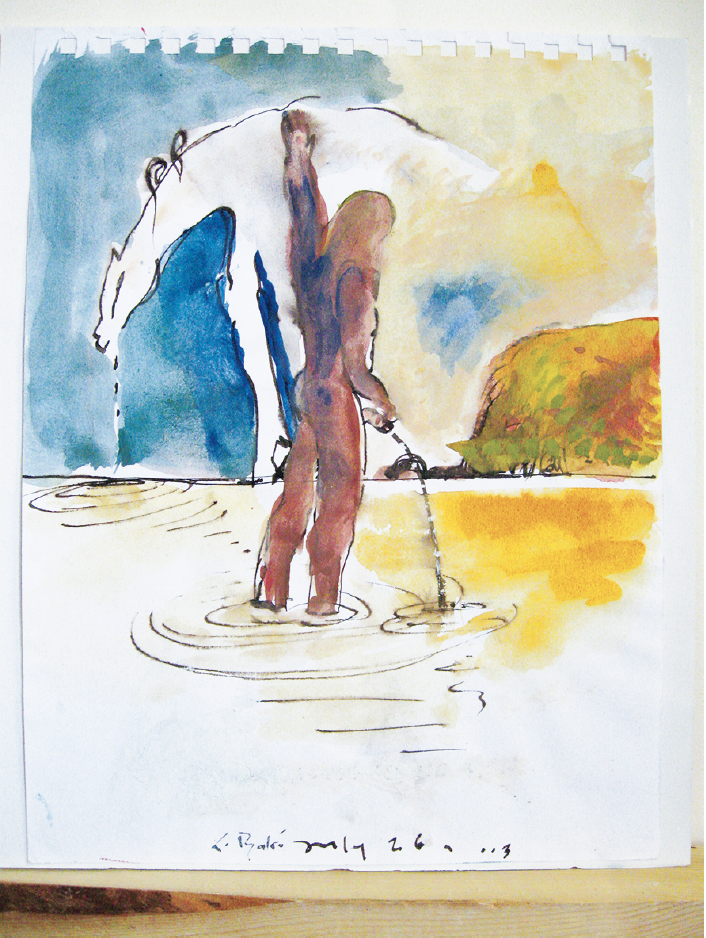Louis C Bakó
The word “retrospective” gets tossed around a lot in the art world, but Louis C Bakó’s new show at the Golden City Fine Art in Winnipeg’s Chinatown has the layered, lived-in feel of the real thing. The works reach chronologically from the early 1970s right up to 2009 and span several media, but they are united in their unabashed expression of pleasure. The show may not be a comprehensive overview—Golden City Fine Art isn’t set up for big exhibitions—but it gives an immediate and evocative sense of Bakó’s creative output, one in which the pleasures of line have mingled with the pleasures of life.
The selection is anchored with three large-scale acrylic paintings, and Bakó has thrown in some mixed-media works, including sculptural pieces assembled from unexpected found objects (rusted railway nails, animal skulls). But the aesthetic and emotional core of the show lies in the drawings. Worked in ink or coloured pencil, sometimes with added washes of watercolour, these pieces are small and intimate, framed simply and then propped casually against the gallery walls. Many pieces measure 8 by 11 inches; a few are the size of index cards. Some still have the holes where they were ripped from a sketchbook.

Louis Bakó, Weeping Horse, 2003, watercolour on paper, 11 x 14”. Courtesy the artist and Golden City Fine Art, Winnipeg.
Born in Hungary in 1943, Bakó emigrated with his family after the Hungarian revolution, landing briefly in England before continuing on to Canada. After studying at the School of Art at the University of Manitoba from 1962 to 1966, Bakó worked with the city planning department, continuing to paint, draw and construct in his studio. He also collaborated on set designs for MTC in the early days of Tom Hendry and John Hirsch.
Though his roots are in the late Modern period, Bakó makes his own way. He often references those stages in 20th-century art when Modernism liked to mess with the genres of academic art: he experiments with the nude, the studio interior, the mythological theme that slides toward eroticism, the still life that warns of the skull beneath the skin. These works pay homage to art history, but any traditional trappings are cut with taut, tough draughtsmanship, frank sexuality and an intensely personal feel. There are centaurs and spirit horses here, but there’s also a sense that these creatures could be seen today roaming around Winnipeg’s Higgins Avenue or the shores of Lake Winnipeg.
Water is a recurring feature in the artist’s most autobiographical works—Bakó swims every day—and Lake Winnipeg, in particular, is recorded in all its changeable moods. In one small drawing, Bakó sketches a flock of pelicans, catching the gestural line of their take-off. In Coming Home From Devil’s Island, he evokes the darkening sky and choppy waters of an unpredictable inland sea. I Love You Zodiac manages to combine two old-school genres—the marine landscape and the nude—into an idiosyncratic celebration of naked boating. The rubbed-out and effaced letters and numbers in the piece’s upper half are actually the name and phone number of the local Zodiac boat dealer.

Louis Bakó, Girl Reading, 1991, oil on canvas, 16 x 28”. Courtesy the artist and Golden City Fine Art, Winnipeg.
Bakó describes some of the works as “snapshots”—brief, expressive jots of moments in his life. Several studio interiors centre on a battered red-velvet sofa, offering a glimpse of casual domesticity. In one sofa piece, Bakó outlines the elegant, angular haunch of a greyhound dog, curled in blameless sleep. In another he draws an imperious cat. He sketches a nude woman, legs drawn up under her on the sofa, with the same intimate hand.
Bakó keeps revisiting the nude, male and female. These works are often immediate and unabashedly carnal, representing bodies that are languid with sex or arched with desire. Sometimes Bakó can be funny (two small pieces that depict men urinating into the lake) or bawdy (Boy with Pig), but he always looks for that hard line of beauty.
Bakó’s art so often celebrates the body and its pleasures that it seems inevitable that some works will explore the other side of this physicality by marking the passage of time and time’s inevitable changes. Two key works stand as memorial pieces. One is for Bakó’s good friend, the artist Linda Pierce. After her death, she left an unfinished ceramic vessel that Bakó glazed in turquoise and gold lustre and then fired. Another piece is a tribute to Walter Lewyk, a Chinatown regular and a longtime participant in the Winnipeg arts community. The large-scale painting Spring Over Love Under combines two Chinese characters with plants and flowers to suggest a life cut short. This slight autumnal note adds to the retrospective feel of the show, with the sense that Bakó is recreating and remembering decades of life and art. ❚
“Louis C Bakó: Looking at You” was exhibited at Golden City Fine Art in Winnipeg from August 14 to September 14, 2009.
Alison Gillmor is the Pop culture columnist for the Winnipeg Free Press and often writes on visual arts and film.

